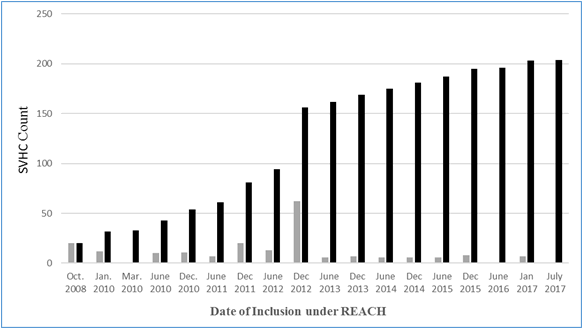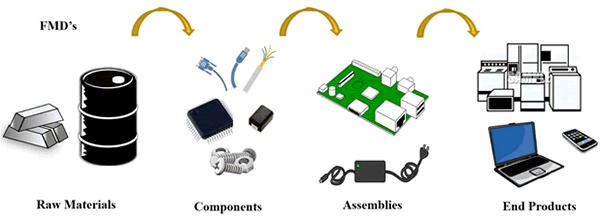Stay Ahead of Regulations with FMDs
Full Material Declarations provide an effective strategy for environmental data reporting.
By Roger L. Franz, Engineering System Analyst, TE Connectivity

Since the European Directives, Restriction of Hazardous Substances (RoHS) and Registration, Evaluation, Authorization, and Restriction of Chemicals (REACH), were enacted in 2006–7, the number of regulated substances continues to grow. REACH adds new substances roughly twice a year, and more substances will be added to RoHS in 2019. While these open-ended regulations represent an ongoing burden for supply chain reporting, electronics companies can stay ahead of new substance restrictions through full material declarations (FMDs), and specifically the IPC-1752A Class D standard, which was developed by the IPC—Association Connecting Electronic Industries.
FMDs of product content can be used by suppliers in the base of the supply chain (e.g., raw materials and small component suppliers), as well as by supplier’s immediate customers, but, although useful, present a challenge for both suppliers and customers. For suppliers, managing substance-level data for all of the various materials a product is made of is an added burden and cost. Customers, from mid-supply chain enterprises to OEMs, must have processes and systems in place to request, manage, and utilize the data to ensure compliance with worldwide substance regulations. Thankfully, there’s a software solution designed to aid FMD reporting with a set of user-friendly, easily accessible, fully supported tools that allow suppliers to validate required data and provide real-time interactive messages to facilitate the resolution of errors.
The IPC-1752A Materials Declaration Management Standard is aligned with IPC-1751A Generic Requirements for Declaration Process Management, which is widely used for environmental reporting. This standard specifies an extensible markup language (XML) schema for mandatory data, offers support for Class D FMDs for homogenous materials and substances required by the RoHS Directive, and is a useful tool for enabling the rapid and accurate reporting of Class D FMDs.
Why Take the Road to FMD?
The primary advantage of the FMD approach is that it is the only way a company can stay ahead of the ongoing addition of regulated substances. RoHS has been relatively static, with only minor changes, and the next addition of four substances, per the European Commissions Delegated Directive 2015/863/EU, will not be enforced until July 22, 2019. However, customers across the supply chain are already asking for data and compliance conclusions for these four substances. This pre-enactment, customer-driven activity clearly demonstrates just how valuable FMDs can be, as suppliers with FMD data can already satisfy their customer’s requests about the presence of both currently restricted substances as well as those that are scheduled to be added to the RoHS.
Since RoHS exemptions are substance-specific and have set expiration dates, it is also prudent for customers to know which, if any, exempted substances are present in order to prevent impending noncompliance. FMD data allows customers to anticipate exemptions that are set to expire and to take early action through product redesigns or alternate suppliers.
REACH, promulgated by the European Chemicals Agency (ECHA), is much more dynamic than RoHS, and adds new substances of very high concern (SVHC) to the candidate list roughly twice a year. Figure 1 shows the number of substances added to REACH since it went into effect in 2008. Shorter gray bars represent the substances added each date, while the larger black bars indicate the cumulative total of candidate list substances.

Figure 1: Number of REACH SVHCs from 2008–Present
Note that there is some double counting in the Figure 1 data, as a few of the substances were listed a second time for different toxicological reasons, and that this count is exclusively based on the ECHA’s primary list of SVHC; the actual individual substance count, i.e., the Chemical Abstracts Service (CAS) number recorded in ECHA supporting documentation, is even greater. As such, the upcoming Amendment 3 of IPC-1752A will contain a non-exhaustive list of substances and their CAS numbers as a convenient reference.
Since FMD is all about chemical data, a product’s chemical composition data is needed to even begin generating FMDs and, unfortunately, there is no other way to manage the complexity of ingredients reported aside from generating a comprehensive materials and substances database or spreadsheet. To assist with this process, some of the major computer-aided design (CAD) systems allow users to select raw materials from a database of CAS numbers and substance names coupled with the CAD system, which is logical since designers are specifying the materials in the first place.
Tools that allow users to search by substance names in addition to CAS numbers can expedite the data entry process by ensuring that valid substance names are paired with valid CAS numbers. Substance names are generally more easily recognized than their CAS numbers, but the disadvantage to this validation approach is that many compounds, and even pure elements, can have several different synonyms. In these cases, a direct CAS number search would be more useful.
The input screen for materials and substances data may look something like Figure 2. This kind of table is the heart of a FMD, where each material is composed of its constituent substances, all with reported weights in the product. Optionally, data like attachment files and concentration ranges may be accommodated. If exemptions apply at the material level, they may also be selected.

Figure 2: Example of a material and substance input screen. © 2017 Assent Compliance Inc.
Suppliers that make raw materials or simple components are more likely to be interested in direct-entry reporting tools than OEMs, but this data becomes the basis of creating FMDs for more complex OEM-level products. Suppliers of the following kinds of items are in one of the best positions to take advantage of these reporting tools:
- Solder and solder flux (separately or in paste or wire)
- Bulk material, like sheets and parts made of a homogenous material
- Metal alloys or parts made from alloys
- Wire
- Mold compound and molded parts
- Underfill
- Conformal coating
- Plating, painted, dipped, and other coatings
- Adhesives, lubricants, and sealants
FMDs for these items can allow next-tier customers to use them for reporting at the next assembly level. Companies on the more complex end of the supply chain may need to use larger enterprise systems to collect this data and run final reports, so the more basic FMD generating tools may be of less interest to them. Figure 3 shows how the data cascade works. As originally envisioned with the first release of IPC-1752 in 2006, the data cascade is still deserving of more widespread understanding and more thorough implementation today. Having effective tools at the very beginning stage of device development can be extremely useful as the data builds in complexity up to reports for more complex products, as even small, personal-use devices can contain hundreds to thousands of components.

Figure 3. Cascade of FMD data
According to some observers, FMDs still have too many barriers to really catch on, but plenty of suppliers disagree. Supply chain reporting has to begin somewhere. Although labor-intensive, FMDs are the only reporting approach that effectively helps minimize the ongoing burden of keeping up with the ever-growing lists of regulated substances and expiring exemptions.
In addition to staying ahead of the growing number of regulated substances, business processes and procedures that support FMDs can also be useful. The expectation that FMDs must be provided can be a requirement for gaining new business or a prerequisite for item qualification and purchase. Companies can also include FMD responsiveness in ongoing supplier evaluation performance ratings that may influence awarding future business. Once an FMD is received in well-formed XML format, loading this data to the customer’s system can be automated for maximum efficiency and reused through the FMD data cascade process.
Useful information about the IPC-1752A Class D standard may be found on the IPC’s Data Exchange Standards page. The story continues, but the message remains clear: Companies need a way to stay ahead of the substances they are required to manage and FMDs are the best way to do so.
This paper was first presented at the 2018 IPC Apex Expo Technical Conference and published in the 2018 Technical Conference Proceedings. The previous article in this series was “Beyond “Lead-Free: An Update on the IPC-1752A Standard for Materials Declaration.”
Visit TE Connectivity online to learn how the company manages product compliance.
Recently posted:
[related_posts limit=”10″]






